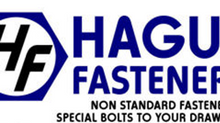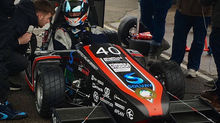Smashing Result from the Impact Testing!
On 28th February, the Crash Structure Manager, Matthew Beck, and Suspension Manager, Nikhil Gomez, visited Cranfield Impact Centre (CIC) to test out two composite crash structures. CIC is an FIA approved facility and enables the dynamic testing of components and large sub-structures. The Anti-Intrusion Plate (AIP) of the first crash structure (CS1) was an 8 ply quasi-symmetric layup utilising a Nomex honeycomb core. The CS1 Impact Attenuator (IA) was constructed from four layers of aluminium honeycomb measuring and five thick aluminium sheets. The aluminium sheets were utilized to guarantee that the honeycomb layers would crush independently and evenly, as well as to provide a better base for the epoxy resin to bond to, which held the IA together. ET500 Epoxy Adhesive, which is recommended for bonding metal to carbon fibre, was used to attach the IA to the AIP. CS1 weighed.
CS1 (left), CS2 (right)
The AIP for the second crash structure (CS2) was constructed out of only two plies of carbon fibre on either side of the Nomex honeycomb core. With layers of aluminium honeycomb measuring, the IA was slightly smaller than CS1. CS2 comprised four layers of aluminium honeycomb and five layers of thick aluminium sheets, similar to CS1. CS2 weighed.

With nine M8 bolts, CS1 and CS2 were bolted onto a steel test rig that was designed to be structurally equivalent to our monocoques composite front bulkhead. For the sled impact test, the test rig is mounted onto a wall and crushed by a non-yielding impact barrier. The sled has a total mass of and collides with the crash structure at a velocity of 7m/s.
The test requirements for the crash structure to pass are presented below:
Ø Decelerate the vehicle at a rate not exceeding 20g average and 40g peak.
Ø The energy absorbed in this event must meet or exceed 7350J
Ø No part of the AIP may permanently deflect more than 25mm beyond the position of the AIP before the test.

S1 was successful, passing all of the test requirements! CS1 was able to absorb 7620J of energy, with a peak 24.47g of an average 13.55g. The AIP for CS1 had a small deformation of 5.35mm . Unfortunately, CS2 did not pass, failing in terms of AIP deflection with a deformation. The IA, on the other hand, was effective in absorbing 7738J , and had a peak g of 25.53g and a mean of 13.27g.

In the above picture, CS1 can be seen on the right and CS2 can be seen on the left where total deformation takes place. CS1 has therefore been chosen to use on the 2022 SHU Racing car. The successful day was documented by Nikhil Gomez and will be uploaded to our YouTube channel in the coming days so stay tuned!
Meet the Team!
Meet the Team is an opportunity for us to give you a chance to learn a little more about the people who make up SHU Racing. This week, we welcome a member of our Powertrain department, George.

Name: George Oliver
Age: 20
Course: Automotive engineering
Role: Drivetrain team member, general helping out ( possible driver ;) )
Number of years on the team: 1
Hobbies and interests: Quad racing, emtb
Favourite car: Peugeot 206
Dream job: Quad racer
Reason for joining SHU racing: Something to do while at uni. Get experience using new machines and learn new things I can apply to my own racing.



































Comments